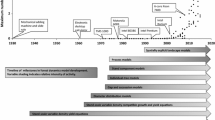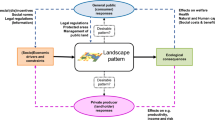Abstract
Spatially explicit dynamic forest landscape models have been important tools to study large-scale forest landscape response under global climatic change. However, the quantification of relative importance of different transition pathways among different forest types to forest landscape dynamics stands as a significant challenge. In this study, we propose a novel approach of elasticity and loop analyses to identify important transition pathways contributing to forest landscape dynamics. The elasticity analysis calculates the elasticity to measure the importance of one-directional transitions (transition from one forest type directly to another forest type); while the loop analysis is employed to measure the importance of different circular transition pathways (transition from one forest type through other forest types back to itself). We apply the proposed approach to a spatially explicit dynamic model, LANDIS-II, in a study of forest landscape response to climatic change in the Boundary Waters Canoe Area (BWCA) incorporating the uncertainties in climatic change predictions. Our results not only corroborate the findings of the previous studies on the most likely future forest compositions under simulated climatic variability, but also, through the novel application of the elasticity and loop analyses concepts, provide a quantitative assessment of the specific mechanisms leading to particular forest compositions, some of which might remain undetected with conventional model evaluation methods. By quantifying the importance of specific processes (transitions among forest types) to forest composition dynamics, the proposed approach can be a valuable tool for a more quantitative understanding of the relationship between processes and landscape composition/patterns.






Similar content being viewed by others
References
Aber JD, Ollinger SV, Federer CA, Reich PB, Goulden ML, Kicklighter DW, Melillo JM, Lathrop RG (1995) Predicting the effects of climate change on water yield and forest production in the Northeastern U.S. Clim Res 5:207–222
Adams MJ (2008) Graph decompositions for demographic loop analysis. J Math Biol 57:209–221
Bachelet D, Neilson RP, Lenihan JM, Drapek RJ (2001) Climate change effects on vegetation distribution and carbon budget in the United States. Ecosystems 4:164–185
Baker WL (1989) Landscape ecology and nature reserve design in the Boundary Waters Canoe Area, Minnesota. Ecology 70:23–35
Baker WL (1992) Effects of settlement and fire suppression on landscape structure. Ecology 73:1879–1887
Baker WL, Egbert SL, Frazier GF (1991) A spatial model for studying the effects of climatic change on the structure of landscapes subject to large disturbances. Ecol Model 56:109–125
Caswell H (2001) Matrix population models: construction, analysis, and interpretation. Sinauer Associates, Inc., Sunderland, MA, USA
Charlesworth B (1994) Evolution in age-structured populations. Cambridge University Press, Cambridge, UK
Dale VH, Joyce LA, McNulty S, Neilson RP, Ayres MP, Flannigan MD, Hanson PJ, Irland LC, Lugo AE, Peterson CJ, Simberloff D, Swanson FJ, Stocks BJ, Wotton BM (2001) Climate change and forest disturbances. Bioscience 51:723–734
de Kroon H, van Groenendael J, Ehrlen J (2000) Elasticities: a review of methods and model limitations. Ecology 81:607–618
Drake BG, GonzalezMeler MA, Long SP (1997) More efficient plants: a consequence of rising atmospheric CO2? Annu Rev Plant Physiol Plant Mol Biol 48:609–639
Frelich LE, Reich PB (1995) Spatial patterns and succession in a Minnesota southern-boreal forest. Ecol Monogr 65:325–346
Güneralp B (2007) An improved formal approach to demographic loop analysis. Ecology 88:2124–2131
Gustafson EJ (1998) Quantifying landscape spatial pattern: what is the state of the art? Ecosystems 1:143–156
Gustafson EJ, Shvidenko AZ, Sturtevant BR, Scheller RM Predicting global change effects on forest biomass and composition in south-central Siberia. Ecol Appl (in review)
Hansen AJ, Neilson RR, Dale VH, Flather CH, Iverson LR, Currie DJ, Shafer S, Cook R, Bartlein PJ (2001) Global change in forests: responses of species, communities, and biomes. Bioscience 51:765–779
He HS, Mladenoff DJ, Gustafson EJ (2002) Study of landscape change under forest harvesting and climate warming-induced fire disturbance. For Ecol Manag 155:257–270
Heinselman M (1973) Fire in the virgin forests of the Boundary Waters Canoe Area, Minnesota. Quatern Res 3:329–382
IPCC (2007) Climate change 2007: synthesis report, Geneva, Switzerland
Iverson LR, Prasad AM (1998) Predicting abundance of 80 tree species following climate change in the eastern United States. Ecol Monogr 68:465–485
Iverson LR, Prasad AM (2001) Potential changes in tree species richness and forest community types following climate change. Ecosystems 4:186–199
Iverson LR, Prasad AM (2002) Potential redistribution of tree species habitat under five climate change scenarios in the eastern US. For Ecol Manag 155:205–222
Jacobson GL, Dieffenbacher-Krall A (1995) White-pine and climate-change: insights from the past. J For 93:39–42
Lenihan JM, Drapek R, Bachelet D, Neilson RP (2003) Climate change effects on vegetation distribution, carbon, and fire in California. Ecol Appl 13:1667–1681
Lenihan J, Bachelet D, Neilson R, Drapek R (2008) Response of vegetation distribution, ecosystem productivity, and fire to climate change scenarios for California. Clim Change 87:215–230
Long SP (1991) Modification of the response of photosynthetic productivity to rising temperature by atmospheric CO2 concentrations—has its importance been underestimated. Plant Cell Environ 14:729–739
Long SP, Ainsworth EA, Rogers A, Ort DR (2004) Rising atmospheric carbon dioxide: plants face the future. Annu Rev Plant Biol 55:591–628
Miller C, Urban DL (1999) Forest pattern, fire, and climatic change in the Sierra Nevada. Ecosystems 2:76–87
Mohan JE, Clark JS, Schlesinger WH (2007) Long-term CO2 enrichment of a forest ecosystem: implications for forest regeneration and succession. Ecol Appl 17:1198–1212
Moser WK, Hansen MH, Nelson MD, Crocker SJ, Perry CH, Schulz B, Woodall CW, Nagel LM and Mielke ME (2007) After the blowdown: a resource assessment of the Boundary Waters Canoe Area Wilderness, 1999–2003. Northern Research Station, U.S. Department of Agriculture–Forest Service, Newtown Square, PA. 63
Neilson RP, Drapek RJ (1998) Potentially complex biosphere responses to transient global warming. Glob Change Biol 4:505–521
O’Neill RV, Krummel JR, Gardner RH, Sugihara G, Jackson B, DeAngelis DL, Milne BT, Turner MG, Zygmunt B, Christenson SW, Dale VH, Graham RL (1987) Indices of landscape pattern. Landscape Ecol 1:153–162
Ollinger SV, Aber JD, Reich PB, Freuder RJ (2002) Interactive effects of nitrogen deposition, tropospheric ozone, elevated CO2 and land use history on the carbon dynamics of northern hardwood forests. Glob Change Biol 8:545–562
Osborn T, Briffa KR (2006) The spatial extent of 20th-century warmth in the context of the past 1200 years. Science 311:841–844
Pastor J, Post WM (1985) Development of a linked forest productivity-soil process model. Report ORNL/TM-9519. Oak Ridge National Laboratory, Tennessee
Rich RL, Frelich LE, Reich PB (2007) Wind-throw mortality in the southern boreal forest: effects of species, diameter and stand age. J Ecol 95:1261–1273
Scheller RM, Mladenoff DJ (2004) A forest growth and biomass module for a landscape simulation model, LANDIS: design, validation, and application. Ecol Model 180:211–229
Scheller RM, Mladenoff DJ (2005) A spatially interactive simulation of climate change, harvesting, wind, and tree species migration and projected changes to forest composition and biomass in northern Wisconsin, USA. Glob Change Biol 11:307–321
Scheller RM, Mladenoff DJ, Crow TR, Sickley TA (2005) Simulating the effects of fire reintroduction versus continued fire absence on forest composition and landscape structure in the Boundary Waters Canoe Area, Northern Minnesota, USA. Ecosystems 8:396–411
Scheller RM, Domingo JB, Sturtevant BR, Williams JS, Rudy A, Gustafson EJ, Mladenoff DJ (2007) Design, development, and application of LANDIS-II, a spatial landscape simulation model with flexible temporal and spatial resolution. Ecol Model 201:409–419
Schumacher S, Bugmann H (2006) The relative importance of climatic effects, wildfires and management for future forest landscape dynamics in the Swiss Alps. Glob Change Biol 12:1435–1450
Shafer SL, Bartlein PJ, Thompson RS (2001) Potential changes in the distributions of Western North America tree and shrub taxa under future climate scenarios. Ecosystems 4:200–215
Starker TJ (1934) Fire resistance in the forest. J For 32:462–467
STATSGO (1994) State soil geographic (STATSGO) data base. Report number 1492. U.S. Department of Agriculture National Cartography and GIS Center, Fort Worth, TX
Sun L, Wang M (2007) An algorithm for a decomposition of weighted digraphs: with applications to life cycle analysis in ecology. J Math Biol 54:199–226
Turner MG (1990) Spatial and temporal analysis of landscape patterns. Landscape Ecol 4:21–30
Turner MG, Gardner RH, O’Neill RV (2001) Landscape ecology in theory and practice: pattern and process. Springer, New York
van Groenendael J, Dekroon H, Kalisz S, Tuljapurkar S (1994) Loop analysis: evaluating life-history pathways in population projection matrices. Ecology 75:2410–2415
Wardle GM (1998) A graph theory approach to demographic loop analysis. Ecology 79:2539–2549
Westerling AL, Hidalgo HG, Cayan DR, Swetnam TW (2006) Warming and earlier spring increase western U.S. forest wildfire activity. Science 313:940–943
Xu C, Gertner GZ, Scheller RM (2007) Potential effects of interaction between CO2 and temperature on forest landscape response to global warming. Glob Change Biol 13:1469–1483
Xu C, Gertner GZ, Scheller RM (2009) Uncertainties in the response of a forest landscape to global climatic change. Glob Change Biol 15:116–131
Zuidema PA, Brienen RJW, During HJ and Güneralp B (2009) Do persistently fast-growing juveniles contribute disproportionately to population growth? A new analysis tool for matrix models and its application to rainforest trees. Am Nat 174:709–719
Acknowledgements
U.S. Department of Agriculture McIntire-Stennis funds (MS 875-359) were used to support this study. We thank two anonymous reviewers for their very helpful comments which greatly improved this manuscript.
Author information
Authors and Affiliations
Corresponding author
Electronic supplementary material
Below is the link to the electronic supplementary material.
Rights and permissions
About this article
Cite this article
Xu, C., Güneralp, B., Gertner, G.Z. et al. Elasticity and loop analyses: tools for understanding forest landscape response to climatic change in spatial dynamic models. Landscape Ecol 25, 855–871 (2010). https://doi.org/10.1007/s10980-010-9464-3
Received:
Accepted:
Published:
Issue Date:
DOI: https://doi.org/10.1007/s10980-010-9464-3




